No.3李炫Unit8教学设计
- 格式:doc
- 大小:241.50 KB
- 文档页数:6
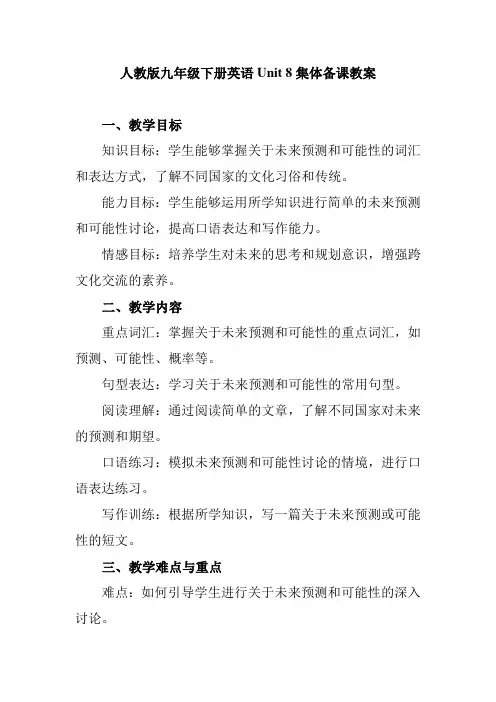
人教版九年级下册英语Unit 8集体备课教案一、教学目标知识目标:学生能够掌握关于未来预测和可能性的词汇和表达方式,了解不同国家的文化习俗和传统。
能力目标:学生能够运用所学知识进行简单的未来预测和可能性讨论,提高口语表达和写作能力。
情感目标:培养学生对未来的思考和规划意识,增强跨文化交流的素养。
二、教学内容重点词汇:掌握关于未来预测和可能性的重点词汇,如预测、可能性、概率等。
句型表达:学习关于未来预测和可能性的常用句型。
阅读理解:通过阅读简单的文章,了解不同国家对未来的预测和期望。
口语练习:模拟未来预测和可能性讨论的情境,进行口语表达练习。
写作训练:根据所学知识,写一篇关于未来预测或可能性的短文。
三、教学难点与重点难点:如何引导学生进行关于未来预测和可能性的深入讨论。
重点:掌握关于未来预测和可能性的词汇和表达方式,了解不同国家的文化习俗和传统。
四、教具和多媒体资源黑板:用于书写重点词汇和句型。
投影仪:播放关于未来的视频资料,增强学生对未来的感性认识。
教学软件:用于进行互动练习和测试。
五、教学方法激活学生的前知:通过提问学生未来的规划和梦想,激活学生的相关背景知识。
教学策略:采用讲解、示范、小组讨论、案例分析等多种教学方法,引导学生积极参与课堂活动。
学生活动:组织学生进行关于未来预测和可能性的讨论,提高学生的思维能力和表达能力。
六、教学过程导入(5分钟)通过投影仪展示一些关于未来的图片或视频,吸引学生的注意力。
随后提问学生未来的规划和梦想,引导学生进入本单元的主题。
讲授新课(30分钟)(1)介绍本单元的重点词汇和句型,通过例句和情境模拟帮助学生理解并运用。
(2)阅读理解:让学生阅读一篇关于未来的文章,并提出问题让学生回答,检验学生的理解程度。
(3)口语练习:组织学生进行关于未来预测和可能性的小组讨论,并进行口头表达。
教师给予指导和反馈。
(4)写作训练:让学生写一篇关于未来预测或可能性的短文,要求运用所学知识,注意语法和拼写错误。
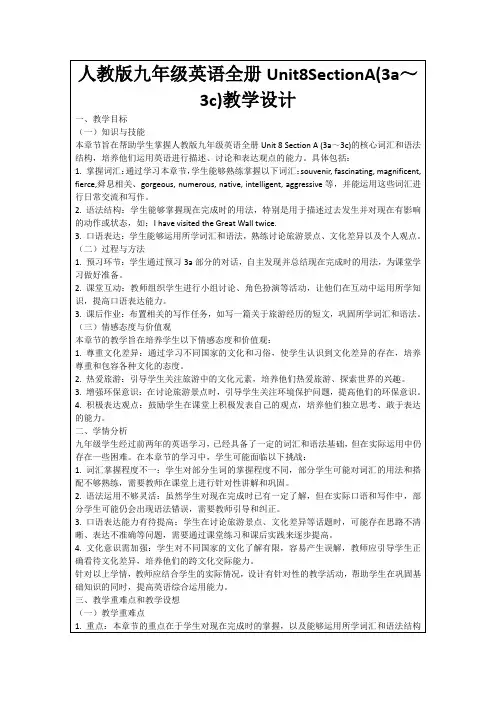
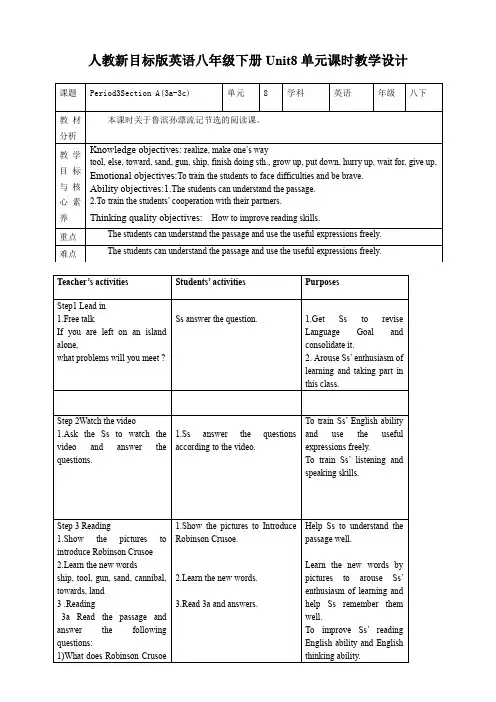
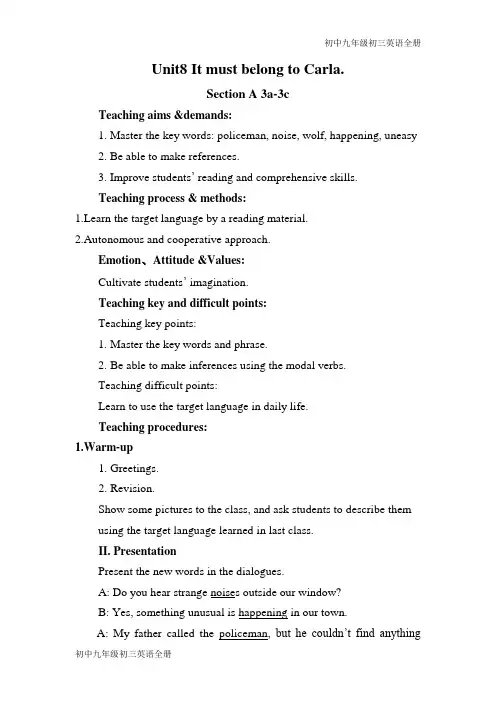
Unit8 It must belong to Carla.Section A 3a-3cTeaching aims &demands:1. Master the key words: policeman, noise, wolf, happening, uneasy2. Be able to make references.3. Improve students’ reading and comprehensive skills.Teaching process & methods:1.Learn the target language by a reading material.2.Autonomous and cooperative approach.Emotion、Attitude &Values:Cultivate students’ imagination.Teaching key and difficult points:Teaching key points:1.Master the key words and phrase.2.Be able to make inferences using the modal verbs.Teaching difficult points:Learn to use the target language in daily life.Teaching procedures:1.Warm-up1.Greetings.2.Revision.Show some pictures to the class, and ask students to describe them using the target language learned in last class.II. PresentationPresent the new words in the dialogues.A: Do you hear strange noises outside our window?B: Yes, something unusual is happening in our town.A: My father called the policeman, but he couldn’t find anythingstrange.B: Maybe it was a wolf , everyone in our town is feeling uneasy.III. ReadingWork on 3a:(1)Leading in.Ask students if they have ever heard any strange noise at night and how they feel.(2)Tell Ss to read the article and decide which might be the best title.(1)A Small and Quiet Town(2)Strange Happenings in my town(3)Animals in our neighborhood3.Get students to read the article again and pay attention to the language points1.It used to be very quiet.used to do sth 曾经,过去常常(现在不做了)2.something unusual is happening in our town.不定代词+形容词(定语后置)e.g. 一些重要的事情something important3….but I couldn't see a dog or anything else, either.too “也” 肯定句句末。
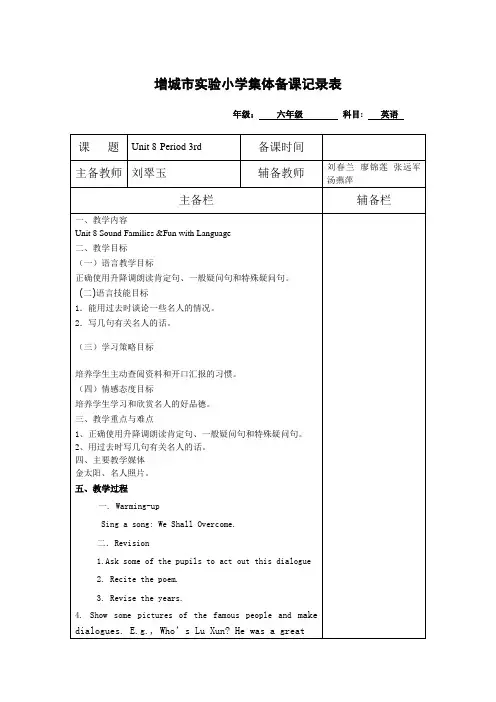
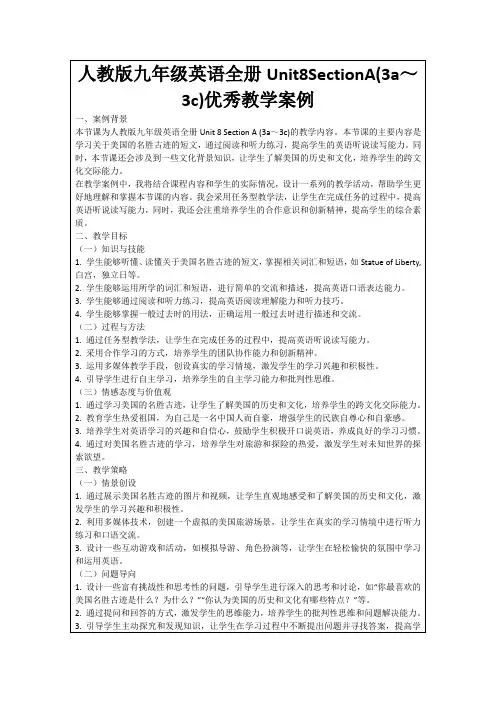
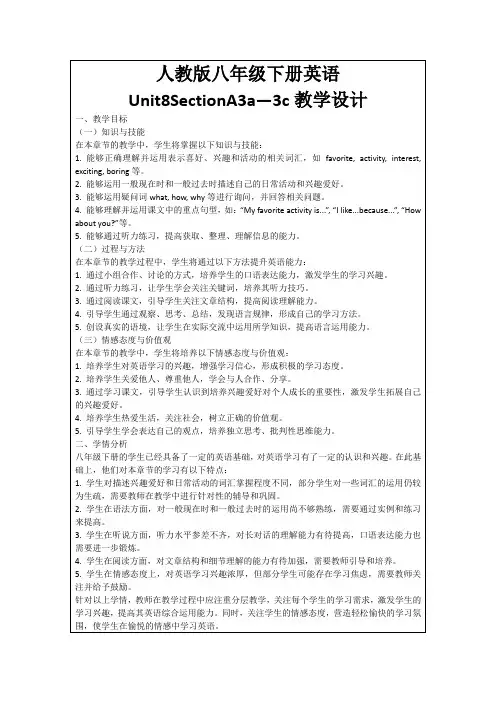
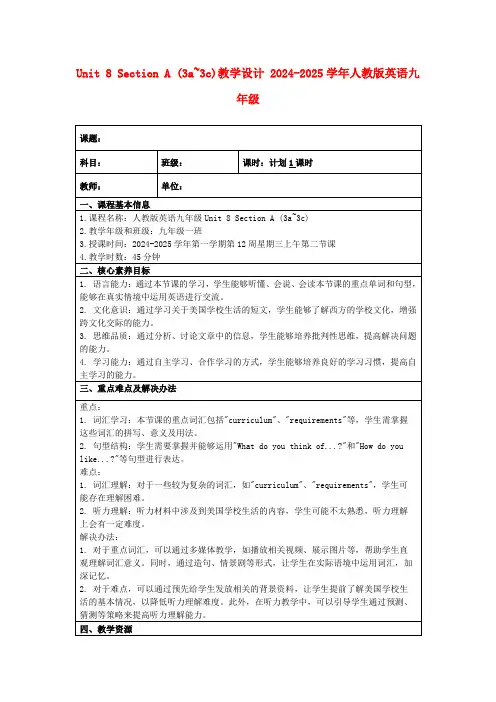
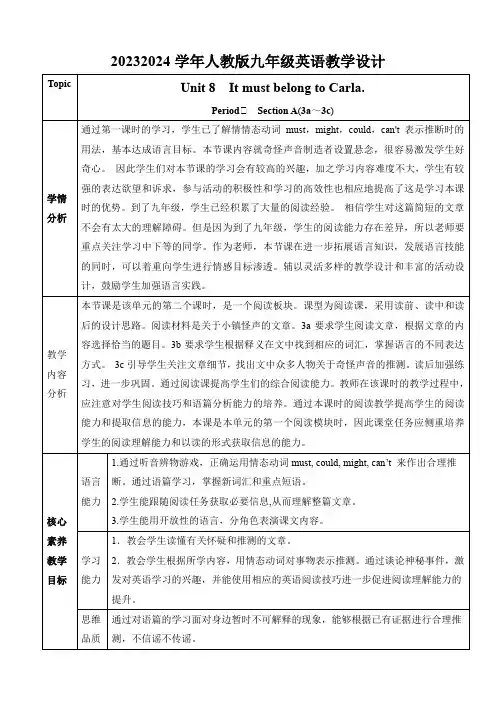
20232024学年人教版九年级英语教学设计二、完成句子。
1.这些天,我们镇上在发生一些非同寻常的事情。
These days,_______________________in our town.2.一定有什么东西在光顾我们社区的人家。
There __________something _______the homes in ourneighborhood.3.这片区域有一位妇女看见什么东西逃跑了。
One woman in the area saw something _____________.4.制造噪声的人/东西在附近引起恐慌,但却很开心。
The noise-maker is ____too much fun ______fear _____the neighborhood.5.我简直无法想象这儿曾经是一个小渔村。
I can't ______that it _______a small fishing village here.情。
Step 7 Summary 跟随老师一起进行内容总结。
利用思维导图总结本课所学内容。
Step 8 Homework 记录作业提高学生运用目标语言的能力。
Blackboard DesignUnit 8 It must belong to Carla.PeriodⅡSection A(3a~3c) Para.1 Something unusual happeningPara.2 People’s idea about the strange noise Para.3 The writer’s opinion about the strange thingsTeaching Reflection:亮点出彩1.本节课的设计体现了任务型教学的设计理念,整个任务链的设计均围绕小镇怪声展开。
怪声引发了小镇居民的种种猜测,使他们陷入了恐之中。
本课内容激发了学生的好奇心,让学生不知不觉进入了课文所设置的场景。
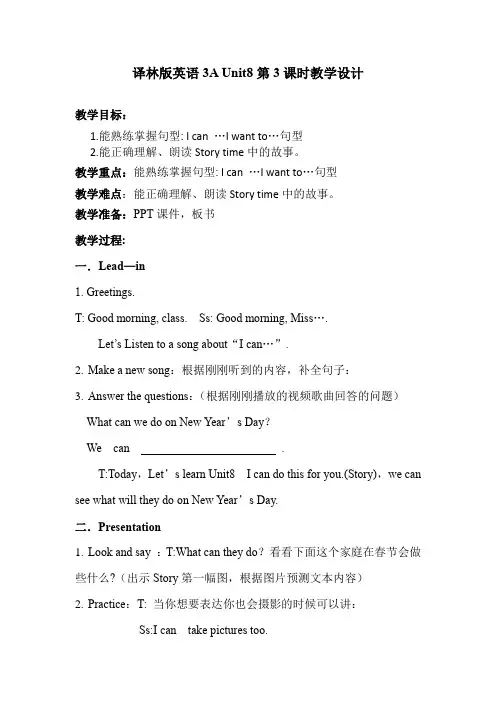
译林版英语3A Unit8第3课时教学设计教学目标:1.能熟练掌握句型: I can …I want to…句型2.能正确理解、朗读Story time中的故事。
教学重点:能熟练掌握句型: I can …I want to…句型教学难点:能正确理解、朗读Story time中的故事。
教学准备:PPT课件,板书教学过程:一.Lead—in1. Greetings.T: Good morning, class. Ss: Good morning, Miss….Let’s Listen to a song about“I can…”.2.Make a new song:根据刚刚听到的内容,补全句子:3.Answer the questions:(根据刚刚播放的视频歌曲回答的问题)What can we do on New Year’s Day?We can .T:Today,Let’s learn Unit8 I can do this for you.(Story),we can see what will they do on New Year’s Day.二.Presentation1.Look and say :T:What can they do?看看下面这个家庭在春节会做些什么?(出示Story第一幅图,根据图片预测文本内容)2.Practice:T: 当你想要表达你也会摄影的时候可以讲:Ss:I can take pictures too.教师总结回顾too的用法3.Read and learn :教师带学生阅读第一段内容,并讲解第一段内容包含的知识点:4.Talk :同桌一组,用I want to 练习句子5.Look and guess:What can they do?看图猜测(出示第二幅图)What can they do?看图猜测(出示第三幅图)6.Think and say:How are their pictures?7.Read and say:阅读整篇文本,完成课后练习题8.Read after tape.三:Practice1.Show time:Act in roles2.Say how many stars your classmates can get3.Retell the story4.Think and say:Do you like family get-together?5.Think and say:What can you do at a family get-together?四.Reading time1.Cover—reading:猜猜Spot是谁的名字?Spot的新年愿望是什么?2.Read and answer四:Homework:画出和家人在一起最快乐的一瞬间!并用英语描述你们在做什么!教学反思:本课为新授课,通过句型的反复播放录音视频并跟读模仿学习句型和单词。
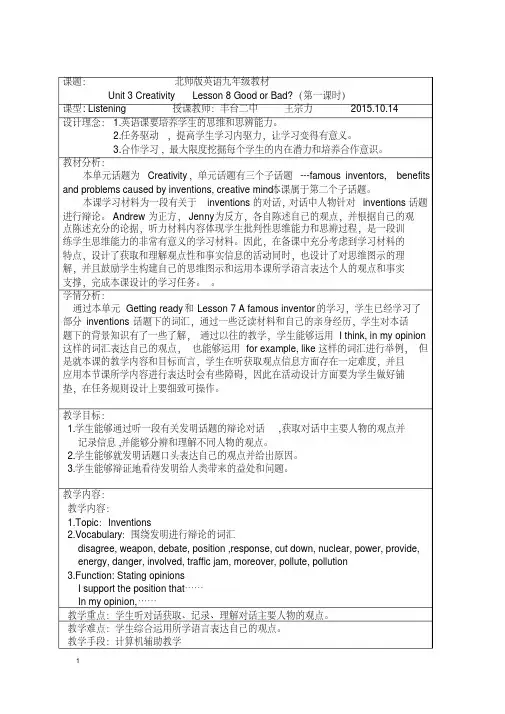
牛津小学英语3A Unit8教案教学设计◆您现在正在阅读的牛津学校英语3A Unit8教案教学设计文章内容由老师制作两转盘,一是地点,一是交通工具,选两个同学,一生抽地点,另一生抽交通工具,依据图片进行对话:S1: Let’s go to …Ss: But ho?S2: By …Unit 8 第三课时Step 1 Free talk 1 T(手拿门票):Let’s go to …S: All right . /OK.Let’s go . / Good . But ho?T: By…2 T(做出相应的动作):Let’s go to … by …S: All right . /OK.Let’s go . / Good . /Great.Step 2 Look and say 1 Take out the picture 生争论2 老师对第一幅图进行示范T: Let’s go to school by bike .S: All right ./ OK.Exchange : S——S3 同学在老师的指引下争论完成练习另外三幅图,并表演,检查Picture 2: Let’s go to the park by bus .All right .Picture 3: Let’s go to the supermarket by car .OK.Picture 4: Let’s go to the Great Wall by plane .Good.Step 3 Fun house 1 Look at the picture and understand the meaning .2 Listen to the tape and finish the exercise .3 Check the anser.Step 4 Exercise book 1 Listen to the tape and finish the exercise .2 Listen and repeat.3 Check the anser.Step 5 Say a rhyme 1 Listen to the tape .2 Read after the tape (or teacher)3 Try to read it together .。
Unit 8 I’d like some noodlesSection A 1a~2c教学目标教学重点:初步学会运用新单词:I’d = I would, would like, noodle, beef, mutton, cabbage, potato, special, large, size, bowl, he’d =he would教学难点:通过教学引导学生学会用目标语言表达如何点餐:1. Hello, I’d like som e noodles.2. What kind of noodles would you like?I’d like beef and tomato noodles.3. What size bowl of noodles would you like?I’d like a small/medium/large bowl of noodles教学过程设计:Step 1 Talk about foodT: How are you today?Ss: I’ m f ine, thanks. How are you?T: I’m fine, too. And I’m very happy today. Do you know why?Ss: No.T: Because I opened a new noodle house.(通过PPT出示我所开的面馆)【设计意图】通过提问的方式引发学生的好奇心,通过很自然的方式导入本课。
Task 1 Review the food【设计意图】通过复习之前所学习的食物oranges, apples, bananas, hamburgers 等导入新单词的学习(beef,mutton,potato等),以旧带新,能引发学生的好奇心,激发学生的学习兴趣。
Task 2 Read these words给学生1分钟的时间通过小组学习,以六人为一小组,成绩好的同学带成绩稍弱的同学读新单词,大声朗读,做到每个同学都能开口大声读(beef, chicken, mutton,potato, tomato, noodles, cabbage)【设计意图】通过优生带读,学生小组学习的方式,带领其他同学共同学习,1是能使基础较为薄弱的同学通过带读的方式迅速掌握个单词的发音,2是通过小组学习的方式,使同学们及时发现错误,教师纠正错误。
3是为教学的下一个环节(quick response)做准备.Task 3 Match the words with the foods.【设计意图】在这个环节中,要求学生能准确辨认各个单词的意思,准确地与相应的图片相匹配,巩固新单词Task 4 Quick response【设计意图】通过上几个环节的新授,朗读和搭配大部分同学都掌握了本节课重点的生词,因此设计这一环节,使学生进一步巩固新知识。
Step 2 Order food在第一个环节中,我们复习了很多食物的名称,也学习到了很多新单词,T:Are you hungry? Ss: Yes.T: Let’s go to my noodle house.(Show a picture of my noodle house)【设计意图】通过一问一答的方式展示面馆的一些特色菜, 出示单词(special),从而导入各种类型的特色菜(special 1,special 2,special 3等)T:Here are many kinds of noodles. So what kind of noodles would you like? 通过展示各类特色菜,导入目标语言:A:What kind of noodles would you like?B: I’d like…Task 1 Pairwork【设计意图】这一环节,通过学生两两组队,进行口头练习,使学生在这一环节中对目标语言进行巩固练习。
Task 2 Memory ChallengeS1:beef noodlesS2:beef potato noodlesS3:beef potato cabbage noodlesS4: beef potato cabbage mutton noodles【设计意图】记忆挑战,使同学们能在短时间内挑战自己,在有限的时间内熟记单词,本环节采用小组比赛的方式,更加激发了学生的竞争意识,在学生学习的同时,为课堂增添活力。
Task 3 GroupworkA: What kind of noodles would you like?B: I’d like …A: What kind of noodles would he/she/they like?C: He’d/She’d/They’d like …【设计意图】通过ABC三个同学的小组练习,使同学们正确掌握其他人称的用法。
Task 4 1b Listen and Check (√) the noodles that the boy orders.向学生播放准备好的视频资料(在某个面馆里,老师扮演服务员,另一人扮演顾客)___special 1 ____special 2 ____special 3【设计意图】本段视频是在现实中的面馆里拍摄的,通过现实生活中的一段结合课文的视频,既接近生活,又能引导学生教导学生如何使用目标语言在生活中点餐。
紧接着出示一张碗的图片问学生:What’s this?学生不会,再出示音标/ bəul/ 通过音标让同学们拼读单词,再教授Different kinds of noodles(a small bowl of noodles ,a medium bowl of noodles, a large bowl of noodles)Task 5 PracticeA: What size bowl of noodles would you like?B: I’d like a small / medium/ large bowl of noodles.【设计意图】本环节随机叫同学们两两练习,通过本环节的练习使同学们基本掌握本句型,为下一环节做准备。
Task 6 Look and Say【设计意图】出示几个学生的图片,(他,她,他们),通过目标语言:A: What size bowl of noodles would he/she/they like?B: He’d/ She’d/ They’d like…使同学们在看图片时能快问快答,以巩固此句型。
Task 7 2aListen and check (√) the names of the foods you hear.2b Listening【设计意图】在以上的很多个环节中,我们学习并初步掌握了目标语言,在此环节中,让我们的语言回归到外国人真正交谈的语言氛围中,感受他们的语音,语调并答题。
Step 3 Order food in a noodle house本环节旨在对前两个环节的一个巩固,引导学生学会如何在餐馆点餐。
Task 1 Watch a video & Answer questions看视频材料然后回答下列问题:1.What kind of noodles would the girl like?2.What size bowl of noodles would the boy like?【设计意图】出示一个在餐馆点餐的视频,回答问题,1.锻炼了学生的听力能力,2. 通过本视频,让学生了解怎样在餐馆点餐。
Task 2 Show TimeMake a dialogue between the waiter (服务员) and the customer (顾客) with your partner.♦Eg: A: Can I help you?♦B: Yes, please. I’d like some noodles.♦A: What kind of noodles would you like?♦B: I’d like ….♦A:What size bowl of noodles would you like?♦B: I’d like … .♦A: What about you?♦C: I’d like … .How much is it?♦A:10yuan.♦B: Here you are.♦A: Thank you very much!Step 4 ExerciseA: Can I help you?B: Yes, please. .A: ?B: I’d like mutton and potato noodles.A: ?B: I’d like a medium bowl of noodles.A: ?C: Me too. How much are they?A: 18yuan,please.B: .A: Thank you very much.【设计意图】通过当堂训练,使学生能熟练通过目标语言补全对话,巩固本堂课的重点句型。
Summary【设计意图】通过对本堂课重点单词,重点句型的回顾,总结本课的重点,让学生进行巩固,再一次明确重难点。
情感目标:出示几张图片,让学生知道we should eat healthy food and do more exercises.HomeworkMake a conversation to order food.【设计意图】本堂课的重点在于使学生学会如何点餐,那么作业的设计也对这一点进行了延伸,让学生用自己的语言表达如何点餐,同时也旨在锻炼学生的写作能力。